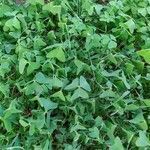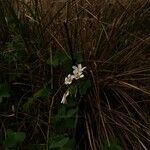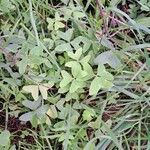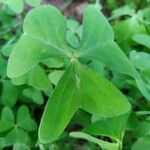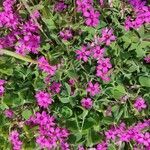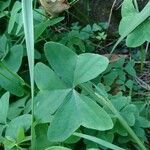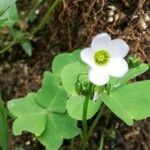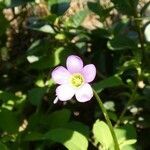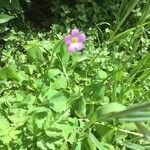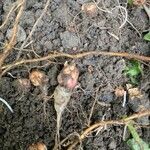Perennial herb with stems not evident, with a fleshy contractile root below the main bulb; bulbs ovoid to globose, pointed, 1–1.5 cm long, tunics creamish or pale brown, vertically ribbed; bulbils formed from old bulbs, sessile. Indumentum of simple, eglandular hairs. Stipules conspicuous, to c. 10 mm long, with rounded or obtuse lobes, the stipular wing long-ciliate. Leaves basal, palmately trifoliolate; petiole 5–30 cm long, glabrous or sparsely hairy; leaflets subsessile, broadly obcordate, 9–35 mm long, 15–53 mm wide, bilobed (sinus up to one-quarter of leaflet length), green, sometimes with maroon markings, glabrous above, glabrous or sparsely pubescent below, margins sparsely ciliate, lobe apices rounded and 12–50 mm apart, calli absent. Inflorescences basal, umbel-like, 6–12 (–15)-flowered; peduncles 7–26 mm long, longer than leaves, glabrous or sparsely hairy; pedicels 10–20 mm long, glabrous or hairy. Bracts situated at base of pedicels, broad lanceolate, 1.8–3 mm long, ciliate, calli absent. Sepals lanceolate, 3.5–6 mm long, glabrous, green with 2 conspicuous orange-brown apical calli. Petals oblong-obovate to narrowly obovate, 9–15 mm long, whitish or very pale mauve-pink, pale yellow and green near base, glabrous. Stamens at 2 levels; filaments hirsute with spreading hairs above, dilated and glabrous below. Ovary glabrous. Styles with appressed, antrorse hairs. Capsules not developed in Australia.
Perennial herb, stemless, with a thick fleshy white root below the main bulb; bulb ovoid to globose, pointed, 1–1.5 cm long, tunics pale brown, vertically ribbed, often ciliate; bulbils formed from old bulbs on stolons to c. 4 cm long. Plants glabrous except for simple, eglandular hairs on filaments and sometimes styles. Stipules conspicuous, to c. 10 mm long, with rounded or obtuse lobes. Leaves basal, palmately trifoliolate; petiole 5–23 (–50) cm long, sparsely hairy; leaflets subsessile, cuneate-deltoid, 9–45 mm long, 17–75 mm wide, bilobed (sinus wide, to c. one-third leaflet length), green, sometimes maroon-flecked, glabrous above, sparsely pubescent below, calli absent, margins sparsely ciliate, lobes triangular, divergent, apices rounded and 12–70 mm apart. Inflorescences basal, 6–14-flowered; peduncles 10–35 cm long, longer than leaves, sparsely hairy; pedicels 10–20 mm long, glabrous. Bracts at base of pedicel, lanceolate, 2–3 mm long, with a single linear apical callus. Sepals lanceolate-elliptic to elliptic, 3–5.5 mm long, glabrous, green with 2 conspicuous orange-brown apical calli. Petals 10–16 mm long, pink to purple, white at base, glabrous. Stamens at 2 levels; filaments of longer set hirsute above, glabrous and dilated below, shorter set sparingly hairy. Ovary glabrous. Styles glabrous or hairy (in long-styled flower). Capsules not developed in Australia.
Stemless herb from bulbous base, no rootstock; bulb ovoid, up to 5 by 2 cm, acute, with numerous, basal, ± erect stolons, with a few small scales, ending in ovoid, acute bulbils pale brown when dry; tunics many, outer up to 5 by 2 cm, ovate, acuminate or with terminal leaf, membranous, transparent, white, nerves 3 to several, orange; inner becoming fleshy. Petiole up to 20 cm, ± glabrous. Leaflets ± equal, 1½-7½ by 2-8½ cm, broadly obdeltoid, fishtail-shaped, incised up to halfway, glabrous, beneath subglaucous, often with 2 orange calli in notch, epunctate. Peduncles up to 25 cm, slightly hairy. Inflorescence umbellate, 5-13-flowered. Bracts 2, c. ½ mm, ovate, margin glabrous to strigose, minutely callose or ecallose. Pedicels up to 2 cm, glabrous, filiform. Sepals 4-4½ (-6) by 1½-2(-3) mm, oblong, obtuse, glabrous, indistinctly 3-5-nerved; apical calli 2, orange, not confluent, c. 1 mm long, minutely hastate. Petals 10-20 by 3-6(-8) mm, narrowly obtriangular, truncate, ± oblique, red-purplish with greenish base, crumpled after anthesis. Filaments (SF) 2½-3(-4) and 4-5(-6) mm, puberulous, the longer with a minute tooth. Ovary and staminal tube c. ½ mm stipitate. Ovary 1.5 by ¾ mm, apically sparsely ciliate on the ribs; styles (SF) c. 1 mm, sparsely ciliate; stigma peltate, c. ¼ mm ø, not papillose; ovules 3-6 per cell, in 1-2 rows.
Underground stem reduced to a disc, the leaves and peduncles having bases modified to form nutritive bulb scales. Flowers umbellate. Rather lax, stemless 15-25 cm high. Bulb ovoid or globose, 1-1.5 cm long; scales brown, the outer few, protective only, papyraceous, ciliate, the inner all nutritive, vertically ridged; bulbils numerous, produced on short runners from the base of the bulb. Rhizome none. Leaves 1-5, basal; petioles 8-18 cm long, arising from the scales of the bulb, like the peduncles glabrous or very sparsely villose; leaflets 3, with very short villose petiolules, very broadly obdeltoid, widely incised on the upper margin, 1-2.5 cm long, 2-4.5 cm broad, the lobes broadly ovate-obcuneate, obtuse at the apex, sometimes sparsely ciliate. Peduncles 6-13 fld., rather longer than the leaves; pedicels glabrous, 1-2 cm long. Sepals lanceolate-oblong, 4-5 mm long, with 2 conspicuous orange-brown apical calli. Corolla 1.1-1.6 cm long, violaceous, with a short widely funnel-shaped greenish striate tube; petals widely cuneate, rounded at the apex, 6-7.5 mm broad. Filaments pubescent, the longer shortly and obtusely dentate. Ovary glabrous, the chambers 6-8-ovuled.
Perennial acaulous herb with thick, fleshy, glassy white, contractile root below the main bulb which is surrounded by numerous small bulbils; tunic brown; scales 3-7-nerved. Lvs 3-foliolate. Petiole (5)-10-50 cm long, glabrous or sparsely hairy; stipular wing broad, membranous, long-ciliate. Lamina of leaflets equal or nearly so, sessile, 12-50 × 18-80 mm, broadly fishtail-shaped, shallowly and broadly 2-lobed, glabrous except for ± hairy base, finely reticulate beneath, not punctate; calli 0 or inconspicuous. Infl. c. 10-50 cm tall, pseudoumbellate, c. 5-15-(20)-flowered, glabrous or nearly so; pedicels very variable in length, ± deflexed at first, usually glabrous. Bracts at pedicel base, c. 3 mm long, lacking calli. Sepals 3-5.5 mm long, lanceolate-elliptic to elliptic, glabrous; calli 2, orange, prominent, apical. Petals c. 1.2-1.5 cm long, oblong-obovate, pink, glabrous. Stamens at 2 levels; filaments of longer set c. 4-5 mm long, hirsute above, glabrous and dilated below, shorter set sparingly hairy. Styles < stamens, glabrous or hairy. Capsule not seen.
Herbs perennial, acaulous, rhizomes and stolons absent, bulb solitary; bulb scales (5–)7–9(–11)-nerved, <inner thickened, white, margins hyaline>. Leaves basal; petiole (6–)10–25 cm; leaflets 3, green, obtriangular to obcordate, (15–)25–40 mm, lobed 1/5–1/2 length, <lobes apically rounded>, surfaces glabrous, oxalate deposits absent. Inflorescences umbelliform cymes, (3–)6–10(–12)-flowered; scapes (7–)10–20(–30) cm, glabrous. Flowers usually tristylous, rarely homostylous; sepal apices with 2 orange, <short to elongate, not confluent> tubercles; petals white to pale green proximally with green veins, purple to lavender or pink distally, 9–12 mm. Capsules cylindric, 4–6 mm, glabrous. 2n = 14, 28, 42.
An erect herb. It keeps growing from year to year. It has spreading underground stems which produce many fibrous bulbs. It grows about 30 cm high. The leaves are at the base and have long stalks. The leaves have 3 leaflets. These are triangular and usually with notches at the tip. The flowers are pink. They are in loose umbrella shaped flower arrangements. About 12 flowers occur together.
Perennial herb, up to 250 mm high. Bulbs giving rise to many runners which develop their own bulbils. Leaflets broadly obdeltoid, 10-25 x 2-45 mm, ecallose. Flowers: peduncle > 1-flowered; sepals with 2 conspicuous orange-brown apical calli; corolla violet, tube greenish; Dec.-May.
Acaulescent geophyte, up to 0.25 m high. Bulbs shallow, many, originating from leaf bases, rhizome absent. Leaves basally congested, trifoliolate, leaflets obdeltoid. Peduncles 6-13-flowered. Flowers light pink with greenish tube. Flowering time Feb.-Apr.
Herb, up to 250 mm tall. Bulbs giving rise to numerous runners which develop their own bulbils. Leaves borne on long slender petioles arising from scaly brown bulbs, leaflets broadly obdeltoid, notched on apical margin. Flowers violet with greenish tube.
